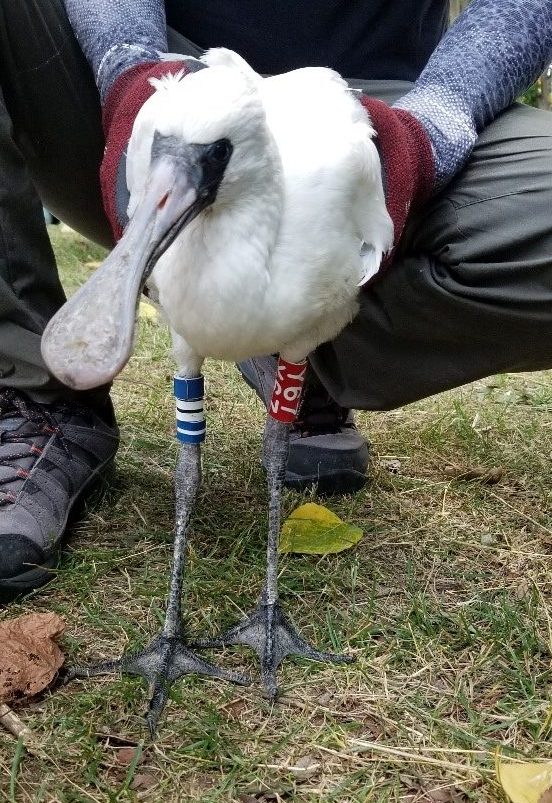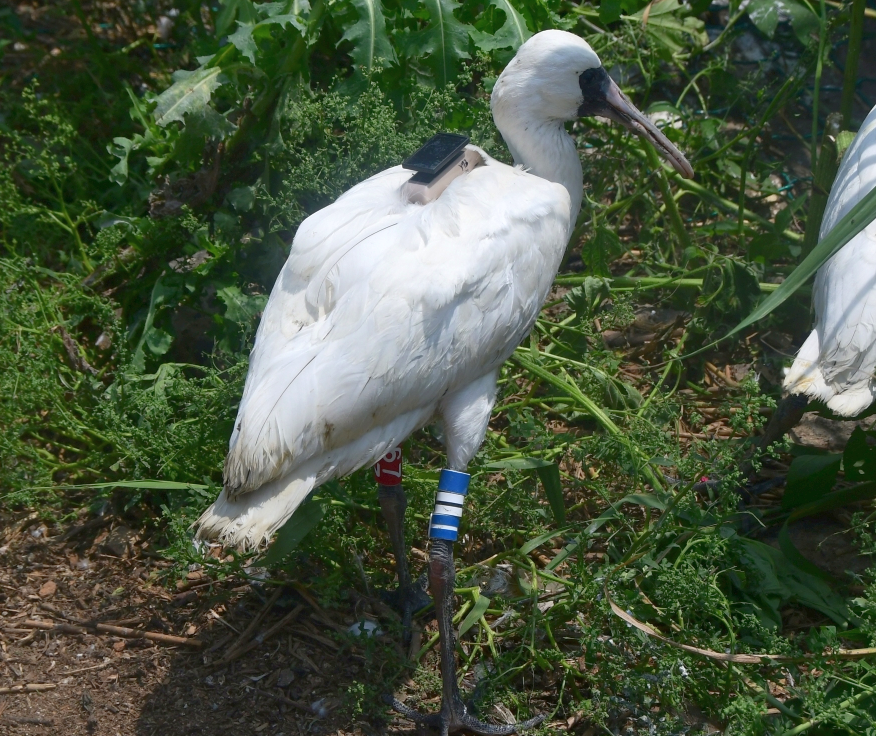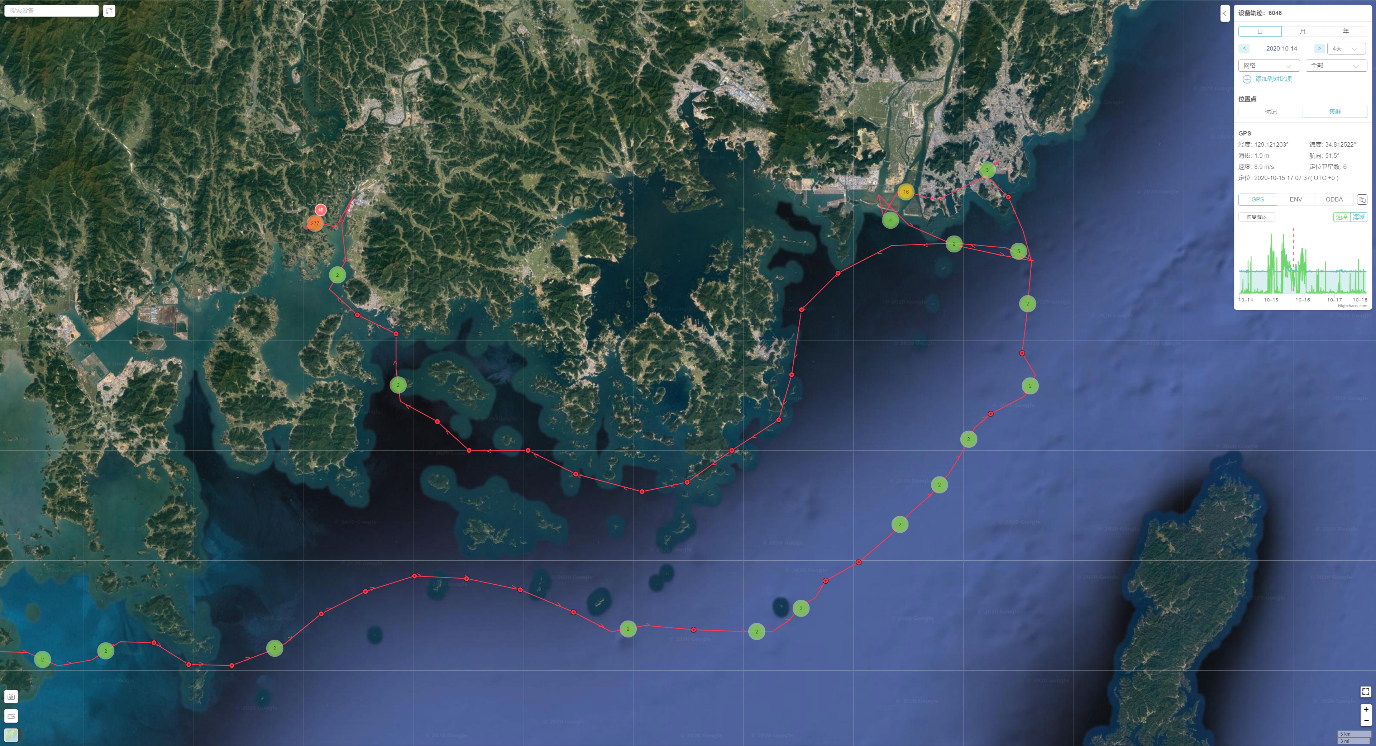The Endangered Black-faced Spoonbill is one of the key species in the East Asian -Australasian Flyway Partnership. The conservation of this globally threatened species had been fostering collaboration and joint actions beyond national boundaries. This year, a joint project between researchers from China and South Korea had been implemented to track the migration of satellite-tagged Black-faced Spoonbill.
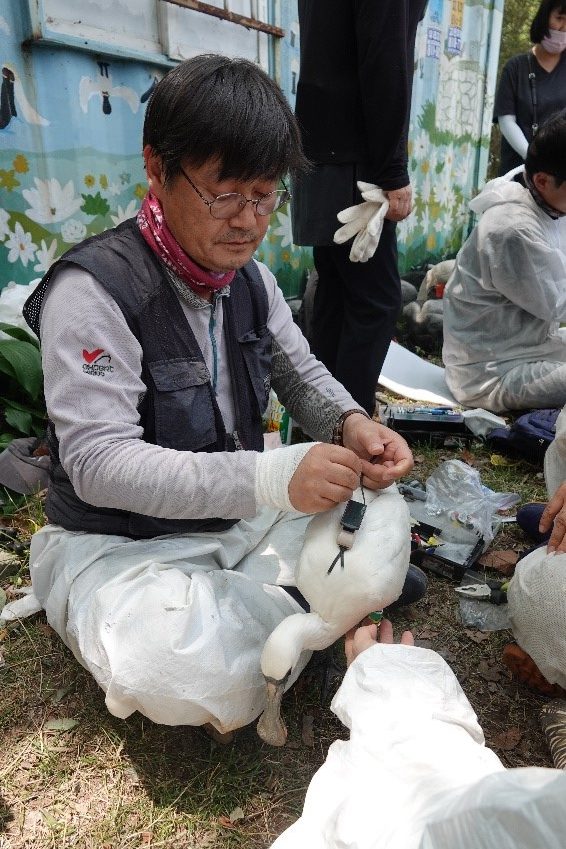
© Vivian Fu/EAAFP
Project background
Populations of many migratory waterbird species along the EAAF have been declining rapidly partly due to habitat loss. The conservation of long-distance migratory waterbird species requires substantial improvement in the protection, management and monitoring of their habitats in wintering, stopover and breeding grounds, with their adequate protection in China particularly crucial.
Among the threatened migratory waterbird species in the EAAF, the Black-faced Spoonbills (hereafter BFS) stands out as one of the very few species showing a recovering trend, from just a few hundreds to more than 4,500 over the last 30 years partly due to the extensive conservation effort and BFSs’ ability to utilise artificial wetlands. Over the years, the foraging ecology (Yu et al. 2004a), habitat use (Yu et al. 2004b), threats (Sung et al. 2018) and migration routes (Wood et al. 2013) of BFS have been studied in various locations. However, very few of these studies were conducted simultaneously beyond local site level to collect quantitative, comparable information to understand drivers behind various population trends in different locations. There is an urgent need to understand the movement, especially juveniles, during winter to gain insights into the key drivers for the various wintering population trends in different wintering sites. In this collaboration between the Southern University of Science and Technology (Shenzhen, China), Waterbird Network in Korea and the National institute of Ecology (Korea), the project aims to:
- quantify the wintering distribution pattern of juvenile BFS using GPS-GSM transmitters;
- determine the potential drivers for the observed juvenile wintering distribution pattern by combining the tracking data with findings from another wintering ground project;
- analyse the tracking data to evaluate the extent to which protected areas along the flyway encompass the full range of habitats used by BFS during non-breeding season.
Updates of Black-faced Spoonbill tracking projects
In June 2020, due to the COVID situation, field work was lead by Dr. Lee Kisup, Chair of Black-faced Spoonbill Working Group, and carried out by the Korean researchers from Waterbird Network in Korea and the National institute of Ecology (Korea) and volunteers. A total of 96 birds (91 juv.+ 5 artificial incubators) marked with colour bands and 25 of them have tracking device deployed.
The banded juvenile birds remained close to the nesting sites but many of them started to explore further in the vicinity for feeding and roosting.
 © Dr. Lee Kisup |
|
 Track location at 9am, 4 September of Y59 and Y67. Y59 prefers Daesong wetlands and Y67 prefers Daebudo big island area. New Maedo Y33 going back and forth Sunjaedo getbol tidal flat and Daesong wetlands |
 Y71 doesn’t go far away from Sorae wetlands park. Photo taken 16:11pm, 13 August. © Dr. Lee Kisup |
After almost 4 months of waiting, we finally had the first GPS-GSM tagged BFS (Y67) embarked on its first-ever migration journey. She left her grow-up place (Ansan) on the morning of 15-Oct, flew south for about 5 hours and had a 3 hours break at Saemangeum. Y67 then continued south and southeast, she made at least two attempts to head east to cross the Korea Strait but the strong head wind might have stopped her from heading further east. She has been resting at Sacheon the last few days.
 The flight path of Y67 |
Our second tagged BFS that embarked its migration journey is Y75. Like Y67, Y75 started her journey in the morning, 3 days later than Y67, from Yeonggwang after several false starts. Unlike Y67, Y75 headed southeast crossing the Yellow Sea. She flew for about 11 hours before landed at Chongming Dongtan, where she rested for about 4 hours. Y75 continued south for another 11 hours, reached Zhejiang Yueqing and eventually settled at Wenzhou. During this finally leg of the flight, she circled around Shanghai Nanhui for a while before headed to Zhejiang. It looks like more and more Spoonbills will head south over the next few weeks so stay tuned for further updates on the southward migration journey of the Black-faced Spoonbill.
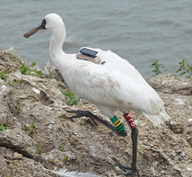 Y75 (Chilsando) © Dr. Lee Kisup |
 The flight path of Y75 |
What Bird watchers can do:
- Contribution to the re-sightings of the Black-faced Spoonbill with leg bands, click [here] for details.
- Join the EAAFP #LegflagChallenge Photo Contest, click [here] for details
Learn more about the researchers’ work:
- Dr. Chi-Yeung Choi (Research Assistant Professor): www.primarilyforests.com/people
- Dr. Kwon In-ki: www.nie.re.kr
Acknowledgement on funding sources:
China Thousand Young Talents Program (K18291101)
EAAFP Small Grants Fund 2020
Chinese version:
合作追踪濒临灭绝的黑脸琵鹭
濒临灭绝的黑脸琵鹭,是东亚-澳大利西亚迁飞区伙伴协定(East Asian -Australasian Flyway Partnership)所关注的重点物种之一。对于此一全球濒危物种的保育,一直以来促进了各种跨越国界的合作与联合行动。而今年,来自中国和韩国的研究人员开展了一个联合项目—运用GPS-GSM追踪器以追踪黑脸琵鹭的迁徙。
项目背景
近年来,东亚-澳大利西亚迁飞区(EAAF)沿线的许多迁徙水鸟物种的种群数量迅速下降,栖息地的丧失便是原因之一。在进行长距离迁徙水鸟的保育时,对其越冬区域、中途停歇地和繁殖区域之栖息地的保护、经营管理与监测,尤其需要实质性的改善,其中,这些迁徙水鸟能否在中国受到充分的保护,便十分关键。
在EAAF受威胁的迁徙水鸟物种中,黑脸琵鹭是其中极少数呈现恢复趋势的案例。在过去30年里,黑脸琵鹭的种群数量从数百只增加到如今的4,500多只,促进其恢复的可能原因,包含了大规模保育工作的推行,以及黑脸琵鹭利用人工湿地的能力。
多年来,黑脸琵鹭的觅食生态(Yu et al. 2004a)、栖地利用(Yu et al. 2004b)、威胁(Sung et al. 2018)以及迁徙路径(Wood et al. 2013)等课题,都已经在各地被广泛地研究。然而,这些研究通常聚焦于区域种群,鲜少有在大尺度下,同时调查不同区域并搜集可量化、可比较的信息,进而了解不同区域种群变化趋势背后的驱动原因。
为了深入了解各越冬地种群变化趋势的关键驱动因素,研究黑脸琵鹭在冬季的移动模式,特别是幼鸟,便显得格外地重要。因此,在这个由中国深圳南方科技大学、韩国水鸟网络(Waterbird Network Korea),以及韩国国家生态研究所(National Institute of Ecology)合作进行的项目中,具有下列主旨:
- 透过GPS-GSM追踪器量化黑脸琵鹭幼鸟的越冬分布模式;
- 结合黑脸琵鹭追踪数据与另一个越冬地研究项目的发现,以厘清幼鸟越冬分布模式的潜在驱动因素;
- 分析追踪数据,以评估迁飞区沿在线黑脸琵鹭非繁殖季所使用的全部栖息地中,被现有保护区覆盖的程度。
黑脸琵鹭追踪项目的近况
2020年6月,由于新冠肺炎疫情,在黑脸琵鹭工作小组主席Lee Kisup博士率领下,由韩国水鸟网络和韩国国立生态研究所的研究人员以及志愿者们执行了实地工作。总计环志了96只黑脸琵鹭(91只自然孵化+5只人工孵化幼鸟),均被系上了可供个体辨识的色环,而其中的25只则被系上了追踪器器。
此时,被环志的幼鸟仍然在营巢地的周围活动,但许多已经开始向外探索,在附近觅食和栖息。
 Y59、Y67和Y33在9月4日上午9点的追踪位置。Y59偏好大成湿地(Daesong),Y67偏好大阜岛 大岛(Daebudo big island),而New Maedo Y33则是往返于仙才岛(Sunjaedo)的滩涂与大成湿地之间 |
 Y71在距离苏莱湿地生态公园(Sorae Wetland Park)不远处。照片摄于8月13日下午16:11 |
经历了将近四个月的等待,在我们以GPS-GSM追踪器追踪的黑脸琵鹭中,终于有了第一只踏上迁徙旅程的个体(Y67),这同时也是她此生的第一次迁徙。她于10月15日上午离开了自己成长的地方—安山(Ansan),向南飞了约5个小时,然后在新万锦(Saemangeum)休息了3个小时。接着,Y67继续向南方和向东南方飞行,她至少两次尝试向东穿越朝鲜海峡,但可能是强劲的逆风,阻止了她继续向东前进。最近几天,她一直在泗川(Sacheon)休息。
 Y67的飞行路径 |
我们第二只启程的黑脸琵鹭是Y75。像Y67一样,Y75也在早晨出发,但日期比Y67晚三天,在经历了几次失败的尝试后,她从灵光(Yenggwang)开始了她的旅程。与Y67不同的是,Y75朝西南方飞行并穿越了黄海,她飞了大约11个小时,然后降落在崇明东滩,并在那里休息了大约4个小时。接着,Y75继续向南方飞行11个小时,抵达浙江乐清市,并最后落脚在了温州。在这段飞行旅程的最后,她曾在上海南汇周围盘旋了一段时间,然后才前往浙江。在未来的几周内,将会有越来越多的琵鹭准备启程南下,因此,请继续关注黑脸琵鹭南向迁移的最新消息。

Y75的飞行路径
观鸟者可以做的是:
了解成员的其他研究成果:
- 蔡志扬 博士 (研究助理教授) www.primarilyforests.com/people
- Kwon In-ki 博士 nie.re.kr
经费来源
中国“千人计划”青年项目(K18291101)
EAAFP小额奖助基金2020
Korean version:
멸종 위기종 “저어새” 추적 협력 프로젝트
저어새(위기,EN)는 동아시아 대양주 철새이동경로 파트너십(EAAFP)의 주요 멸종위기종 중 하나이다. 세계적으로 멸종 위기에 처한 저어새를 보호하기 위해 국경을 초월한 협력 프로젝트가 진행되어 왔으며, 올해에는 중국과 대한민국의 연구원들이 공동으로 위성 추적 가락지가 붙은 저어새의 이동을 추적하는 프로젝트를 수행했다.
동아시아-대양주 철새이동경로를 따라 이동하는 많은 이동성 물새들은 서식지 파괴로 인해 빠르게 감소해왔다. 하지만 멸종위기에 처한 이동성물새 중 저어새는 회복 추세를 보이는 극소수의 종 중 하나로 알려져 있다. 지난 30년 동안 지속적인 보전 노력과 인공 습지에서 서식할 수 있는 저어새의 적응 능력으로 불과 수백 마리에서 4500 마리 이상으로 증가해왔다. 이에 대해 지난 몇 년간 저어새와 관련한 수렵 생태학(Yu et al. 2004a), 서식지 이용(Yu et al. 2004b), 위협(Sung et al. 2018) 및 이동 경로(Wood et al. 2013) 등의 연구가 다양한 지역에서 이루어졌지만, 개별 지역의 범위를 넘어 지역에 따라 달라지는 다양한 개체수 추세의 요인을 이해하기 위한 양적, 비교 연구가 동시에 행해진 경우는 드물었다.
이에 따라 다양한 월동지에서의 저어새 개체수의 변화를 결정짓는 요인들을 이해하기 위한 연구와 저어새 유조의 이동에 대한 연구 필요성이 증대되었으며, 남방과학기술대학교(중국, 심천), 한국물새네트워크, 국립생태원(대한민국)이 함께하는 협력 프로젝트가 성사되었다.
이 프로젝트는 다음과 같은 목표를 가지고 있다:
- GPS-GSM 송신기를 이용해 저어새 유조의 겨울철 분포 패턴을 계량화한다.
- 추적 데이터와 다른 월동지 프로젝트의 결과를 결합하여 저어새 유조의 겨울철 분포 패턴의 잠재적 요인을 확인한다.
- 추적 데이터를 분석하여 이동경로의 보호지역 중 비번식기 동안 저어새가 사용하는 서식지의 범위의 정도를 평가한다
2020년 6월, 저어새 워킹그룹 의장인 이기섭 박사가 현장 조사를 이끌었으며, 한국물새네트워크와 국립생태원의 연구원들과 자원봉사자들이 함께했다. 총 96마리의 새에 유색 가락지를 매달았으며, 그 중 25 마리에 추적 장치를 설치했다.
4개월의 기다림 후 GPS-GSM 추적장치를 매단 첫번째 저어새 (Y67)가 이동을 시작했다. Y67은 10월 15일 아침, 성장기를 보낸 안산을 떠나 약 5시간 동안 남쪽으로 날아가 새만금에서 3시간의 휴식을 취했다. 이후 Y67은 남쪽과 남동쪽으로의 이동을 계속했으며 대한해협을 건너기 위해 동쪽으로 두번 방향을 잡았지만, 강한 바람으로 인해 더 먼 동쪽으로 향하지 못하게 했을 것으로 추정된다. 여정을 계속해오던 Y67은 지난 며칠 동안 사천에서 휴식을 취하고 있다.
두번째 저어새 (Y75)는 Y67이 출발한 후 3일 뒤에, 오전시간 영광 (대한민국)에서 출발하였다. Y67과 달리 Y75는 황해를 건너 남동쪽으로 향했다. 11시간의 비행 후 충밍 동탄(중국)에 도착하여 4시간의 휴식을 취했고, 또 다른 11시간의 남쪽 비행 후 윈저우(중국)에 최종 도착했다. 앞으로 몇 주간 점점 더 많은 저어새가 남쪽으로 향할 것으로 예상된다.

